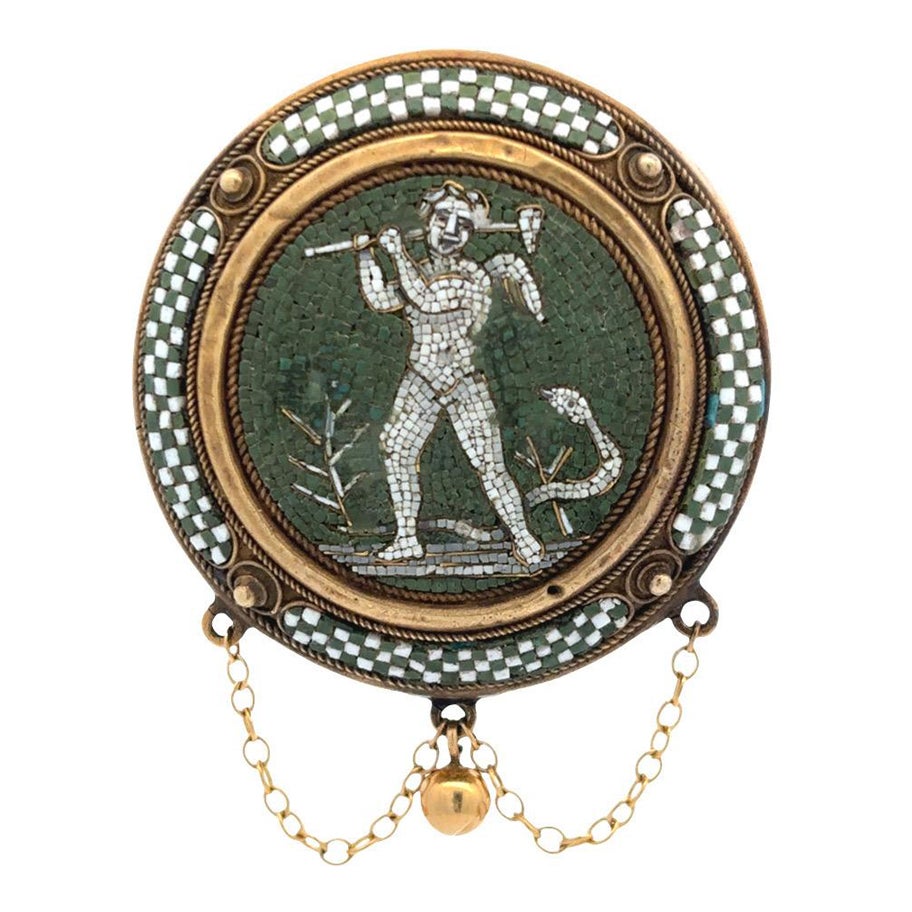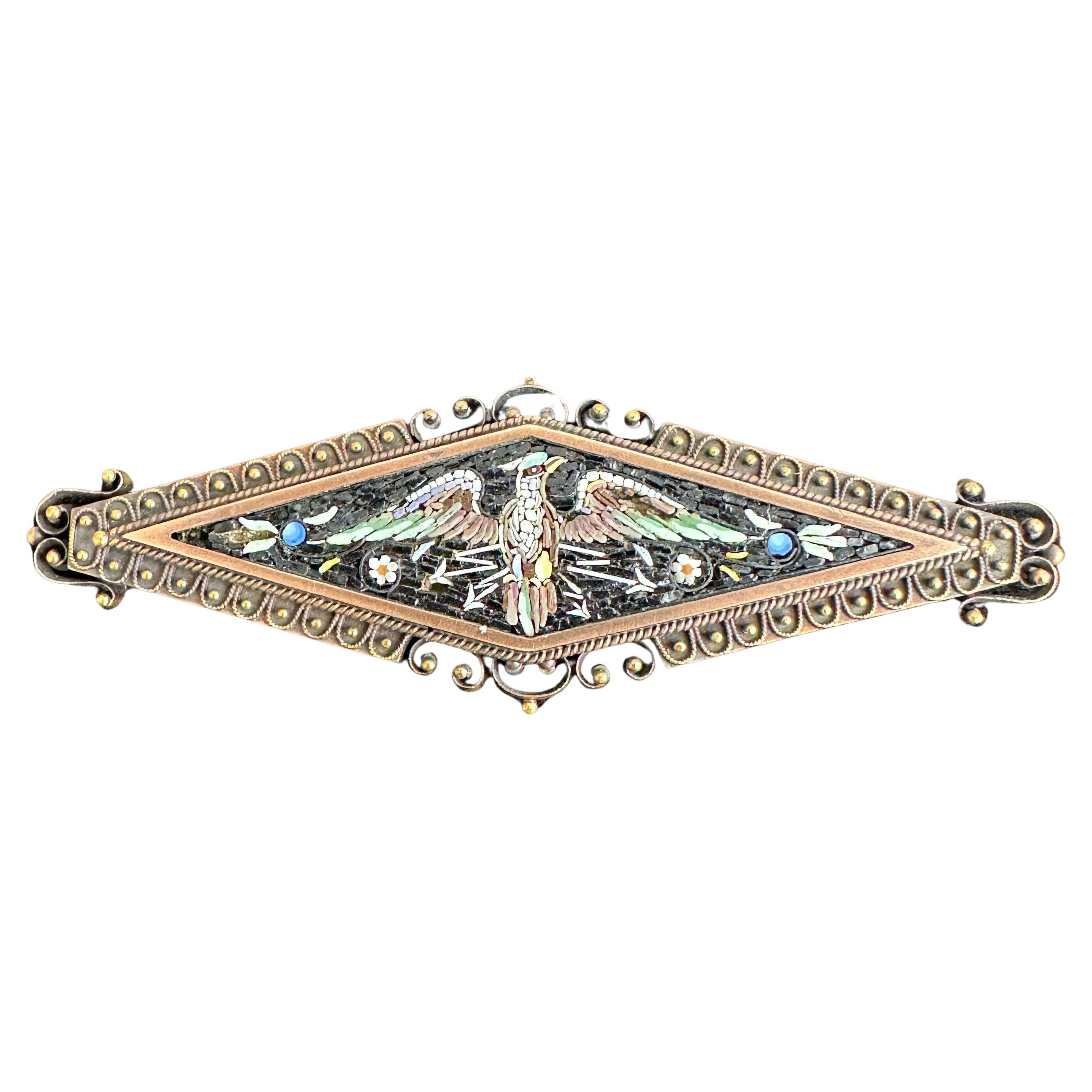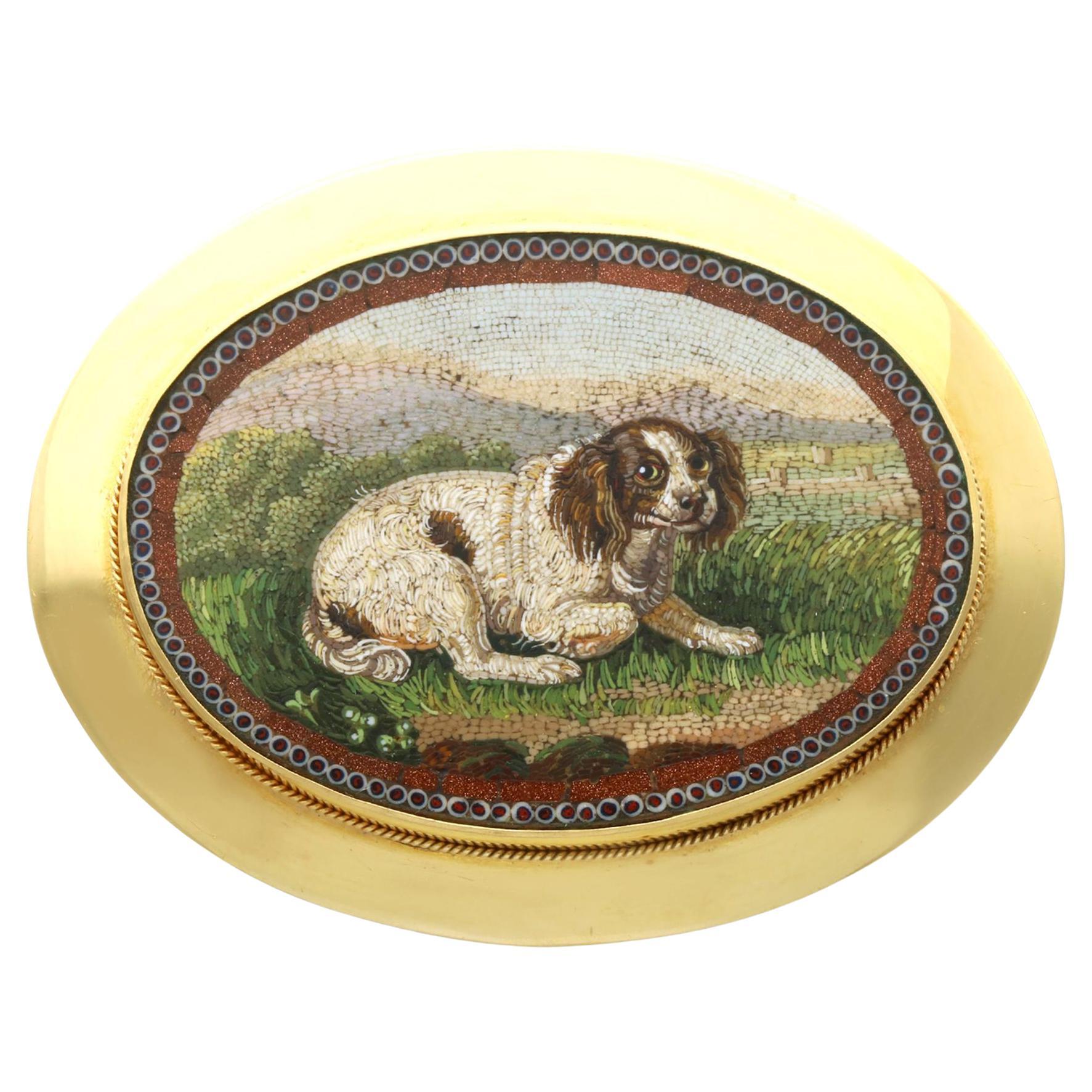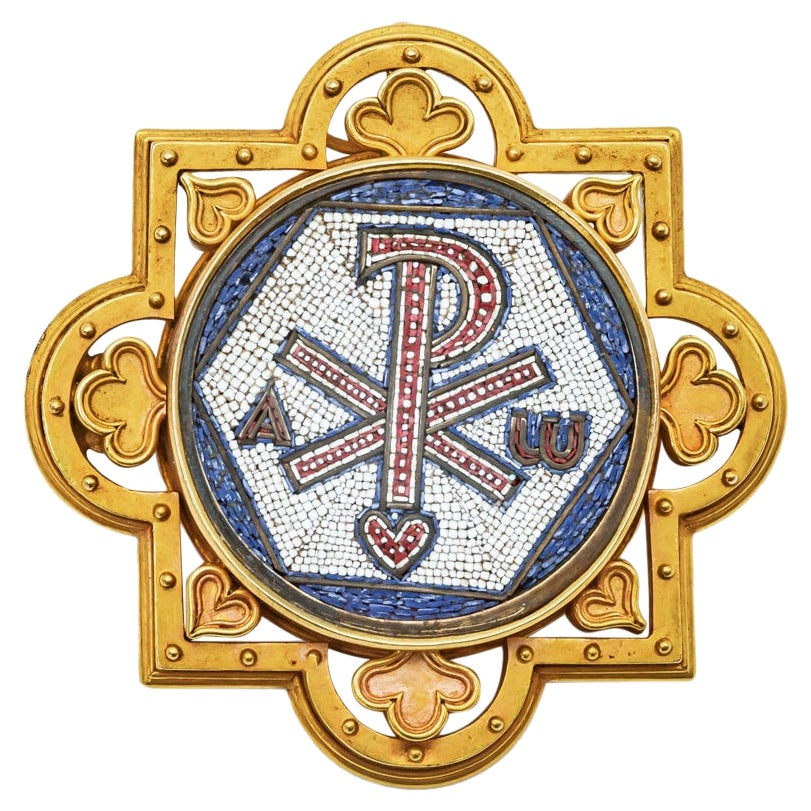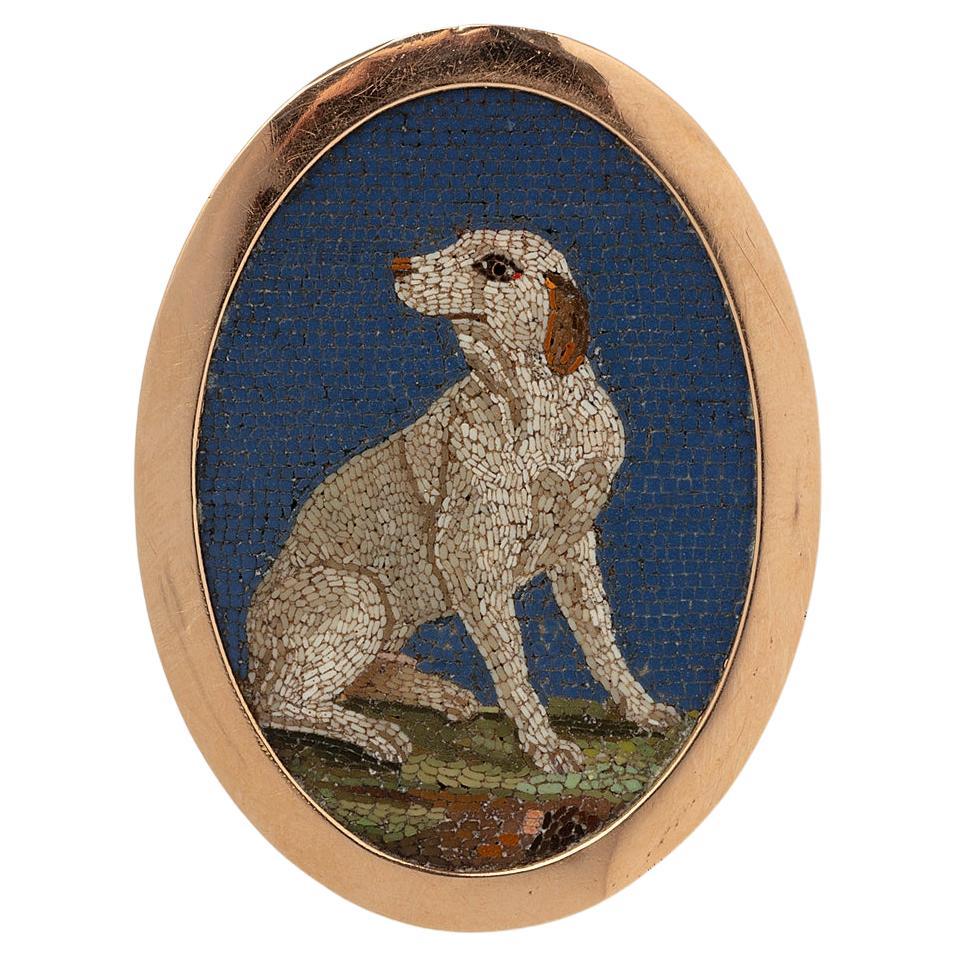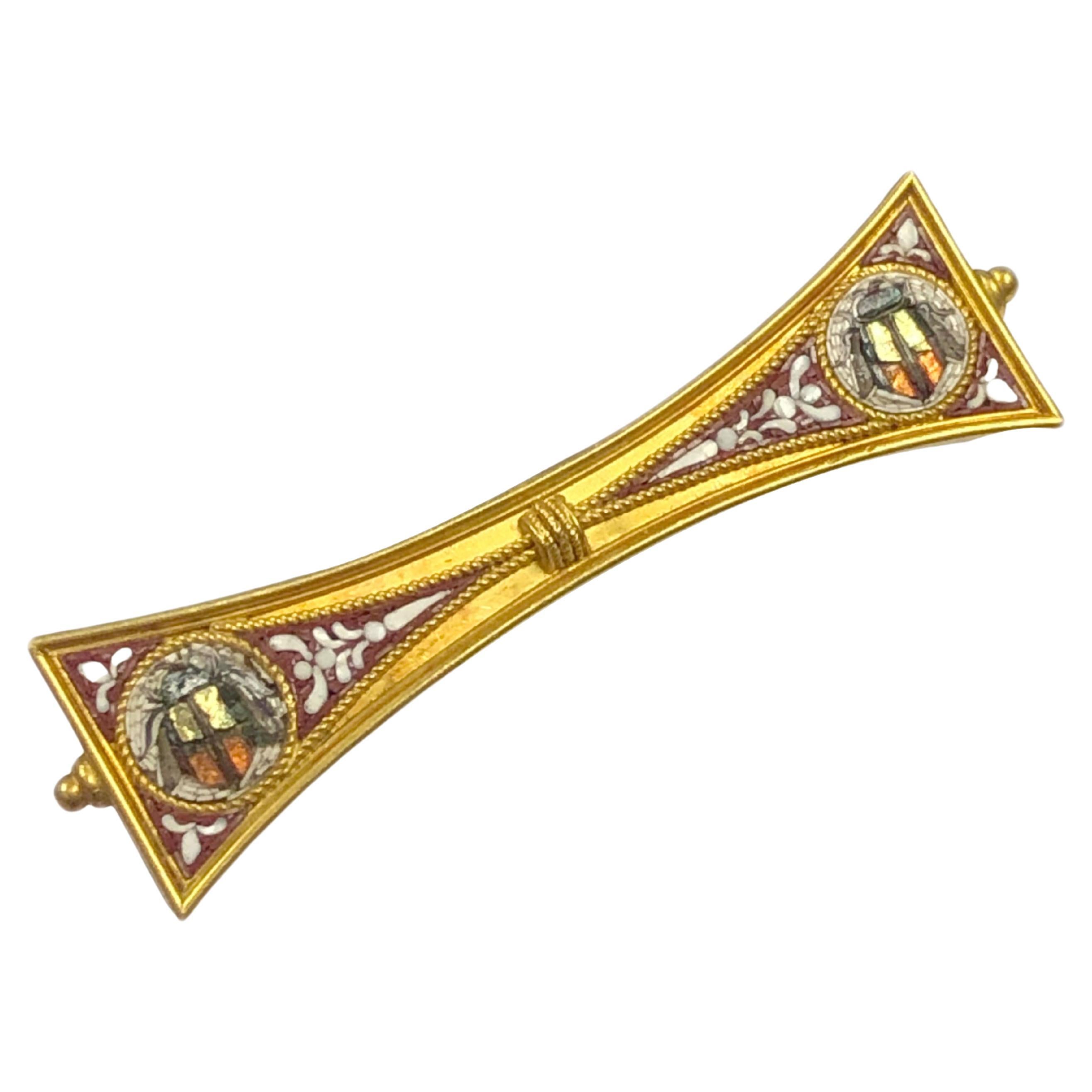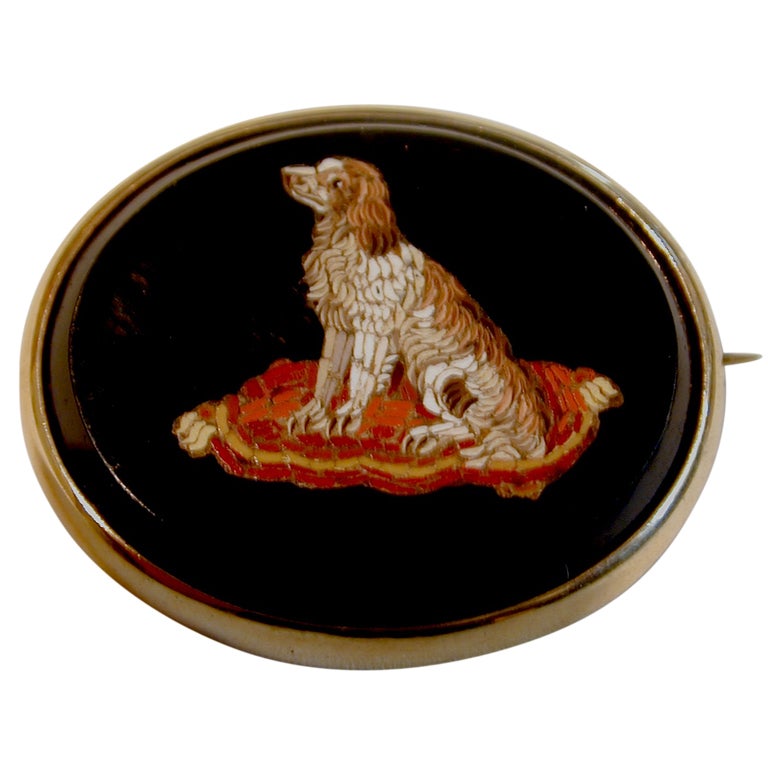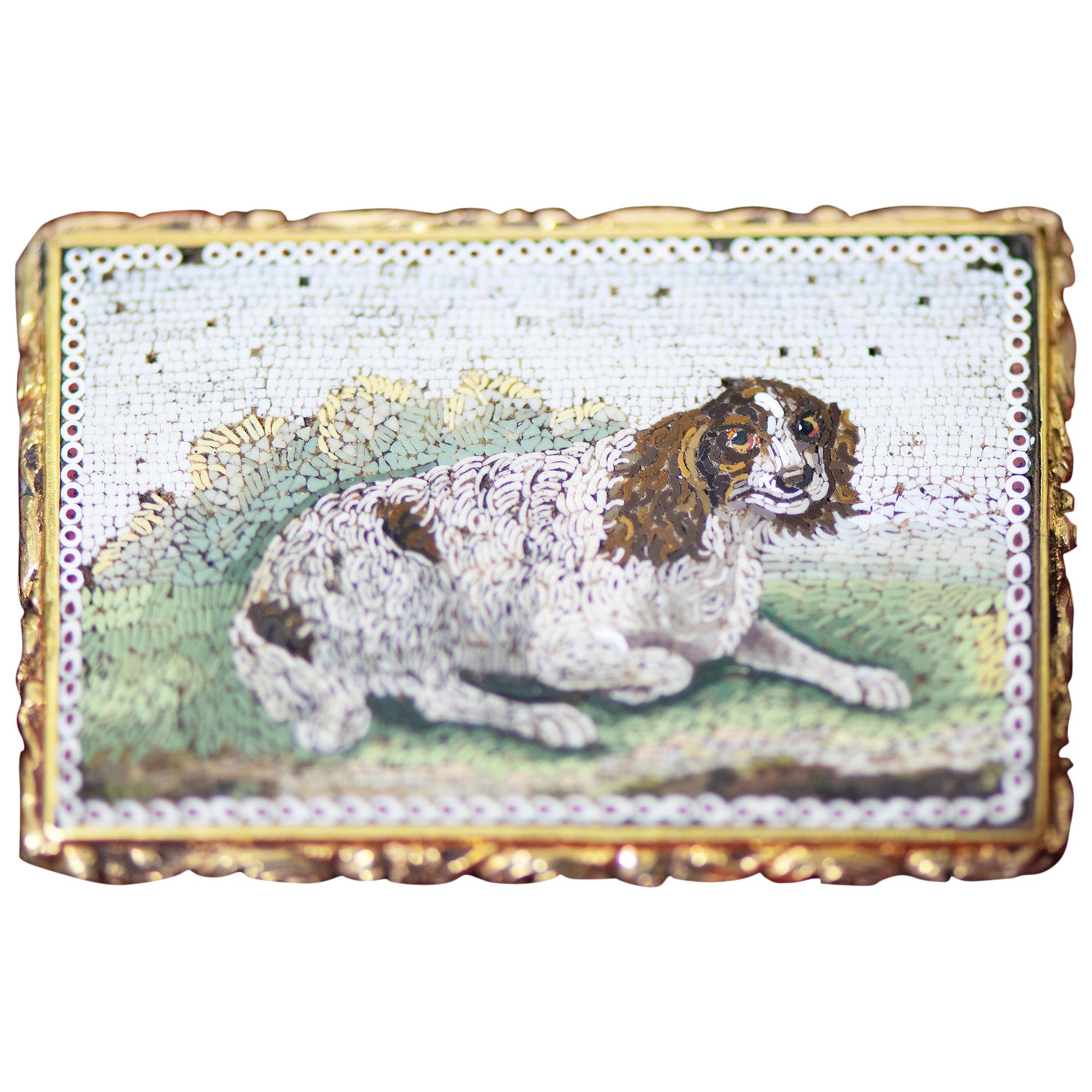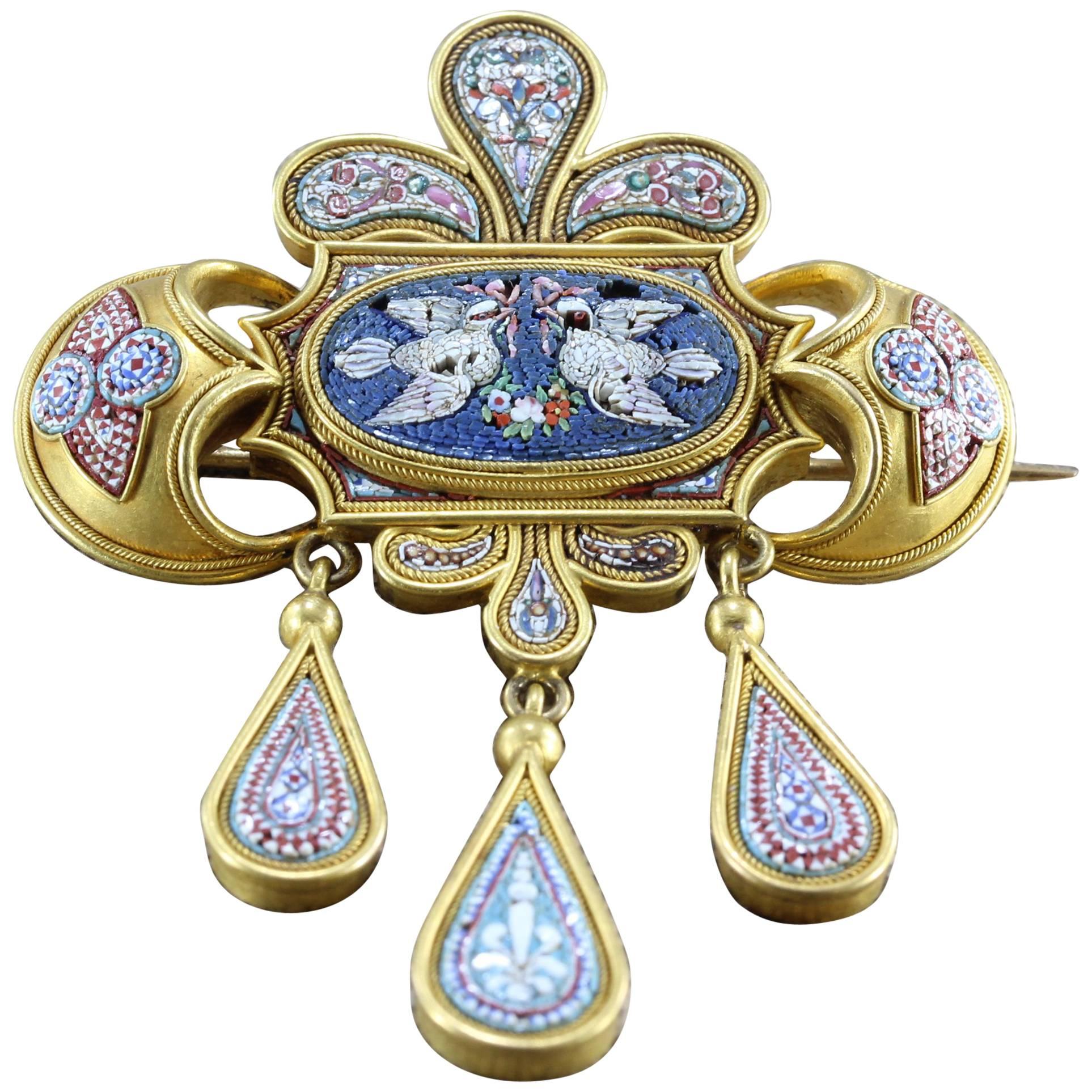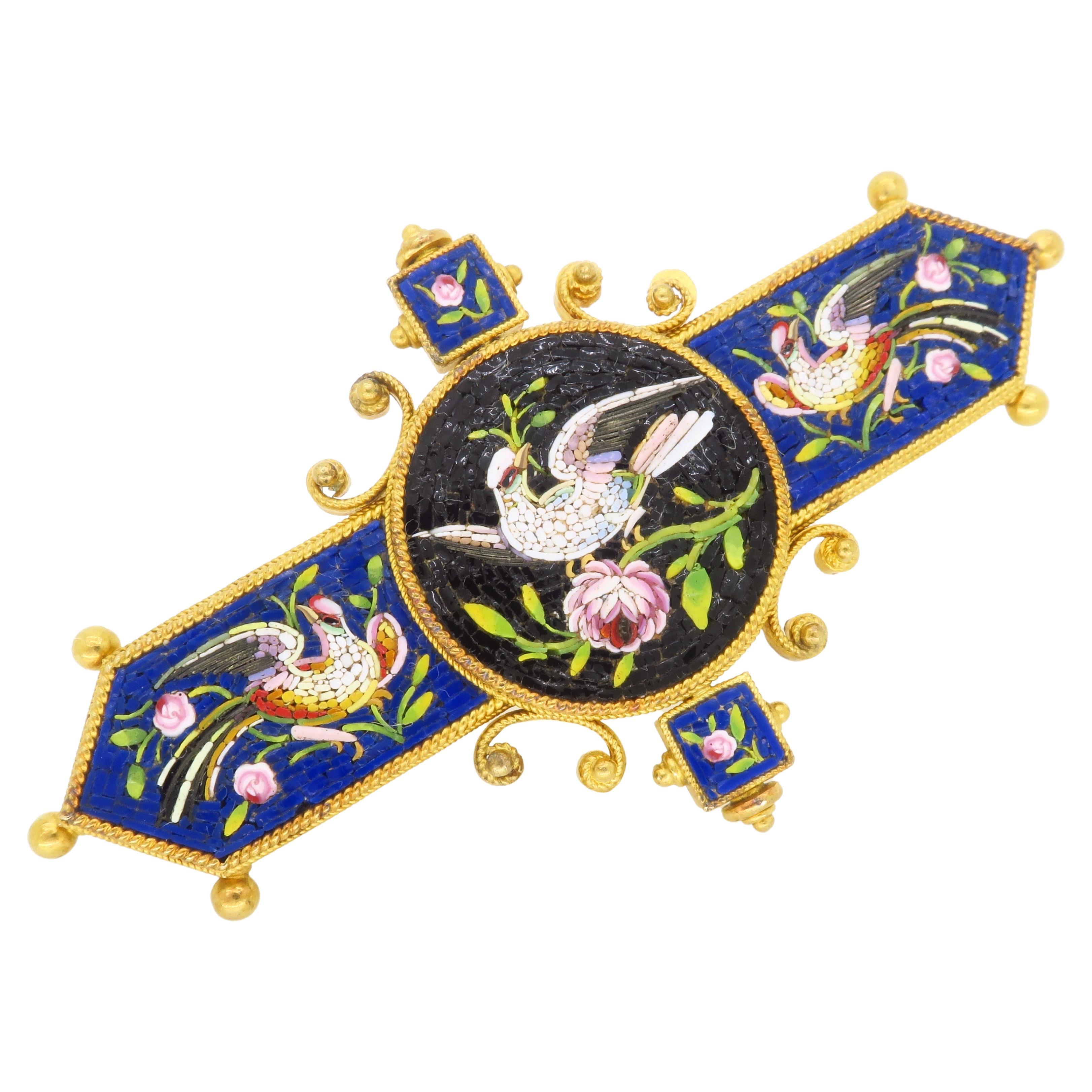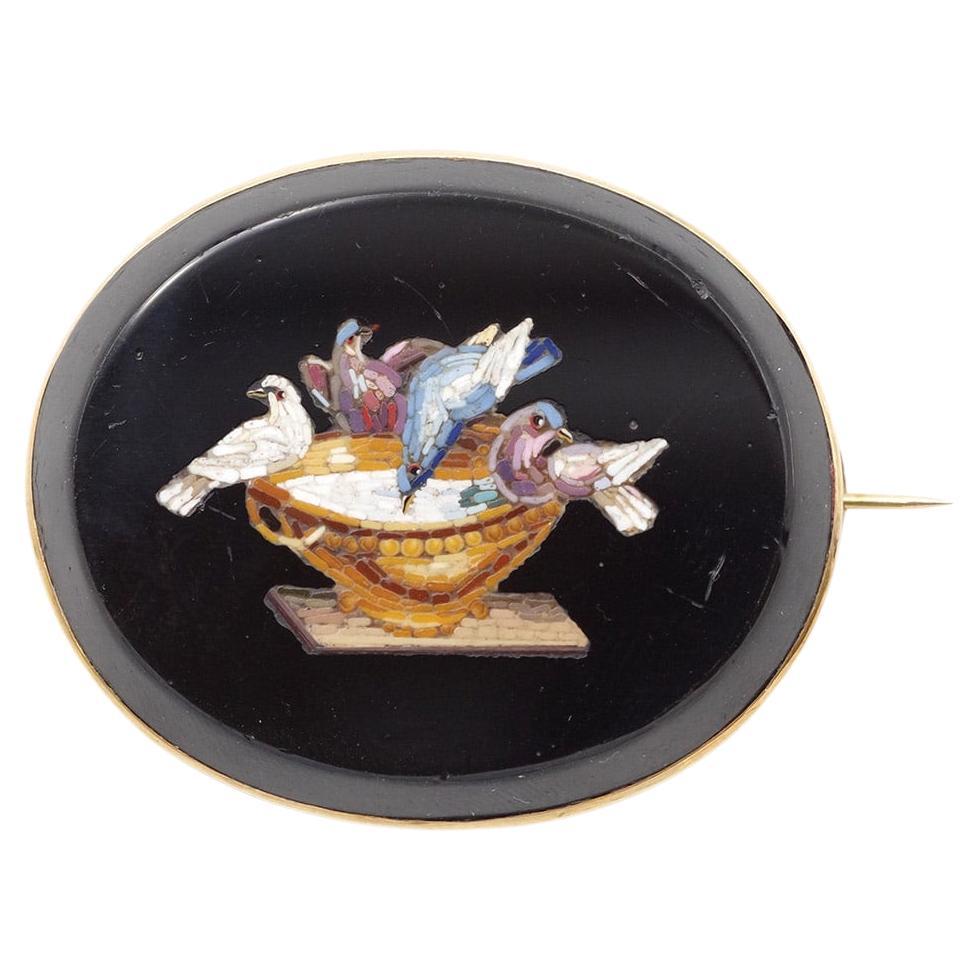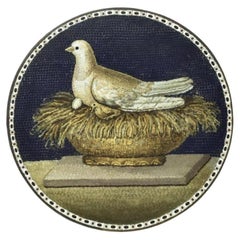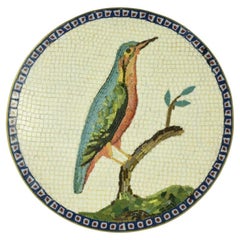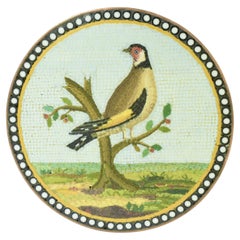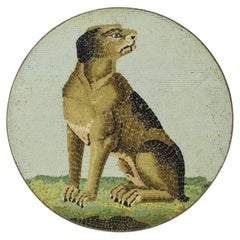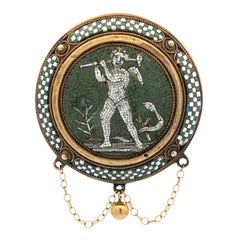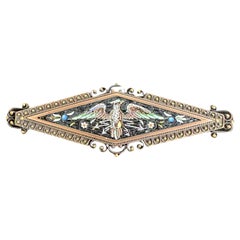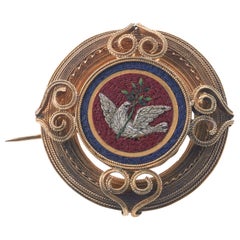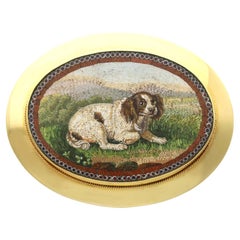
18th Century Micro Mosaic brooch of a Bird and a Bee, circa 1795-1825.
View Similar Items
Want more images or videos?
Request additional images or videos from the seller
1 of 9
18th Century Micro Mosaic brooch of a Bird and a Bee, circa 1795-1825.
$7,950List Price
About the Item
- Metal:Yellow Gold
- Style:Georgian
- Place of Origin:Europe
- Period:18th Century
- Date of Manufacture:1795
- Condition:Replacements made: the clasp and pin stem was updated. Wear consistent with age and use. Pin stem and clasp was updated.
- Seller Location:Aspen, CO
- Reference Number:1stDibs: LU19221049012
About the Seller
5.0
Recognized Seller
These prestigious sellers are industry leaders and represent the highest echelon for item quality and design.
Gold Seller
Premium sellers maintaining a 4.3+ rating and 24-hour response times
Established in 1979
1stDibs seller since 2011
671 sales on 1stDibs
Typical response time: 4 hours
Authenticity Guarantee
In the unlikely event there’s an issue with an item’s authenticity, contact us within 1 year for a full refund. DetailsMoney-Back Guarantee
If your item is not as described, is damaged in transit, or does not arrive, contact us within 7 days for a full refund. Details24-Hour Cancellation
You have a 24-hour grace period in which to reconsider your purchase, with no questions asked.Vetted Professional Sellers
Our world-class sellers must adhere to strict standards for service and quality, maintaining the integrity of our listings.Price-Match Guarantee
If you find that a seller listed the same item for a lower price elsewhere, we’ll match it.Trusted Global Delivery
Our best-in-class carrier network provides specialized shipping options worldwide, including custom delivery.More From This Seller
View All18th Century Micromosaic, Rome, c. 1795, Attributed to G. Raffaelli
Located in Aspen, CO
18th century micromosaic of a turtle dove on her nest with a chick, attributed to Giacomo Raffaelli.
To see a similar plaque, signed and dated Giacomo Raffaelli, 1791; see: Aste Bolaffi Auction House, lot 324, May 31, 2023, Torino Italy.
Birds were a popular motif in micromosaics in the last quarter of the 18th century and into the early 19th century. This mosaic is well executed with fine detail as seen in the shading. Little effort had been made in the dark background to follow the contour of the dove's silhouette, instead keeping the tessera in horizontal rows with square tesserae. The decorative border or millefiori of three colors around the edge create a colorful frame to this delightful scene.
All of these characteristics date this plaque as being late 18th century and most likely executed by Giacomo Raffaelli. For more detailed information, see page 32 of "The Gilbert Collection Micromosaics by Jeanette H. Gabriel. Philip Wilson Publishers. The reader will see the characteristics unique to Raffaelli. Jeannette Gabriel is considered a foremost expert in the work of Raffaelli, and was a statically important participant in the management, development and analysis of the Gilbert Collection. Her observations relative to the work of Raffaelli are therefore quite credible by art historians
This micromosaic is 2 5/8th inches in diameter, and backed in copper which is typical of plaques made at this time. This plaque was probably set onto a box of some sort as it has a glue like substance on the verso, which can be removed. We have chosen to keep this as it came to us, and in an effort to be careful, we have made no effort to remove it.
We have one of the largest collections of micromosaics offered for sale. If our reader is searching for a particular motif, we would be happy to list it here for your consideration. From very large wall hangings...
Category
Antique 1790s Italian Georgian Desk Accessories
$11,120 Sale Price
20% Off
Free Shipping
18th Century Micromosaic Plaque of a Bluebird, attributed to G. Raffaelli.
Located in Aspen, CO
18th Century micromosaic plaque of a bluebird, Rome, c. 1785, attributed to Giacomo Raffaelli (1753-1836). A micromosaic plaque of a blue bird perched on a flowering tree branch, 2.25 inches in diameter. The ground line is parallel and low. The foreground green grass with a brown rock in the front. The background is a creme color with parallel lines of square tesserae. The bird has both square and oblong tesserae as does the foreground. The border of a decorative pattern with three colors with a red circle or dot in a white square on blue. Like most plaque done at this time, it is backed with copper. There is a black substance or adhesive which, centuries ago, could have been applied to adhere this plaque on a box or in a frame. We have chosen to keep this as it came to us, and in an effort to be careful, we have made no effort to remove it.
We have dated this piece as being the last quarter of the 18th century, and attributed to the master mosaicist Giacomo Raffaelli. This micromosaic has all of the established 18th century characteristics of micromosaics executed by Giacomo Raffaelli: 1. Each tesserae possesses one color. 2. The tesserae are either oblong or square. 3. The background is parallel horizontal rows of square tesserae, and 4. The addition of an identical border or millefiori around the edge. For more detailed information, see page 32 of "The Gilbert Collection Micromosaics by Jeanette H. Gabriel. Philip Wilson Publishers.
Raffaelli is known for his very realistic depictions of birds. His naturalism and use of colors is among the finest of mosaicists at this time. Raffaelli became one of the most feted mosaicists in all of Rome. Indeed when Napoleon I wanted to sponsor a mosaic version of the Last Supper in roughly 1810 he chose Raffaelli. This selection itself added to the already high reputation of Raffaelli.
This micromosaic is in very good condition and probably executed by one of the greatest of mosaicists ever and, who is thought by art historians to be the first creator of modern mosaics in the late 18th century.
We have one of the largest collections of micromosaics offered for sale. If our reader is searching for a particular motif, we would be happy to list it here for your consideration. From very large wall hangings...
Category
Antique 1780s Italian Georgian Brooches
$10,400 Sale Price
20% Off
Free Shipping
18th Century Micromosaic of a Goldfinch, c. 1790, attributed to G. Raffaelli
Located in Aspen, CO
18th Century micromosaic plaque of a Goldfinch, Rome, c. 1785, attributed to Giacomo Raffaelli (1753-1836). A micromosaic plaque of a goldfinch, looking left, perched on a red flowering tree branch, two inches in diameter. The ground line is parallel and low. The foreground is of different colors of grass and fallen berries and leaves. The background is a light blue with parallel lines of square tesserae. The goldfinch has both square and oblong tesserae as does the foreground. The border of a decorative pattern in white in black circles and further with a rim of yellow oblong tesserae create a colorful frame for this well executed micromosaic which is backed with copper.
There is a pinstem and "c" clasp (this type of clasp is seen both in the 18th and 19th centuries), both are not gold. This assembly could have been put on at the time of purchase or slightly later so the plaque could be worn as a brooch.
We have dated this piece as being at the end of the 18th century and attributed to Giacomo Raffaelli. This micromosaic has all of the established 18th century characteristics of micromosaics executed by Giacomo Raffaelli: 1. Each tesserae possesses one color. 2. The tesserae are either oblong or square. 3. The background is parallel horizontal rows of square tesserae, and 4. The addition of an identical border or millefiori around the edge. See page 32 of "The Gilbert Collection Micromosaics by Jeanette H. Gabriel. Philip Wilson Publishers.
Giacomo Raffaelli (1753-1836) is one the most important artists of micromosaics, his signed pieces are almost nowhere to be found - unless in museums and important collections of the world. We know of nine that exist in the world. Two in the Hermitage, two in the renowned Gilbert Collection, one in the British Museum, three held by different companies in the trade, and one held by Pierre/Famille ( for sale on this platform). Raffaelli was considered the finest mosaicist in Rome. Indeed, when Napoleon I wanted to sponsor a mosaic version of The Last Supper, in roughly 1810, he chose Raffaelli, this too added much to his fame.
A very similar plaque, also attributed to Raffaelli, can be seen in the above referenced book on page 56. This plaque is part of The Gilbert Collection. The permanent collection is on view at the Victoria & Albert Museum in London.
Raffaelli is known for his very realistic depictions of birds - especially the Goldfinch. While his naturalism is among the finest of mosaicists at this time, Raffaelli chose to display his extraordinary talent featuring the goldfinch in many of his works.
Raffaelli was probably aware of the significance of the goldfinch to the Catholic Church. Afterall, it is one of the most poignant stories in the Passion of Christ. On the road to Golgotha, Christ was forced to carry the cross upon which he would be crucified. He was also made to wear a brutal crown of thorns. It was said that a simple Goldfinch, having alighted on the Savior's shoulder, flew to his head and plucked a thorn that had been making Christ bleed; whereupon this blood was transferred to the finch, which to this day, still wears it. This is but one example as to how mosaics permitted the Church to teach important lessons or parables. Why was this not done by traditional art forms such as paintings? Why was this done instead by mosaics?
From its initial conception at approximately 319 AD, the Church sought to locate St. Peter's Basilica at the site of the apostle's martyrdom. On its face such a decision would seem rational, if not appropriate.
St. Peter however was executed in a marshy area on a side of the Tiber in the already quite humid city of Rome. Housed in the early St. Peters with its exposure for so many centuries of very high humidity most of the Basilica's artwork was beyond the help of the rudimentary preservation and restoration of the period. By about 1750 to which the "new" St. Peters dates it had therefore lost many oil and watercolor paintings as well as wood, bone, and tortoise sculptures, frames and other artifacts.
What could the Church do? Enter the "new" age of Roman micromosaics in which tiny pieces of colored stone or glass when set with grout would prove to be impervious to the debilitating effects of humidity.
By the early 1700's the Church would begin the process of establishing a school of instruction in mosaics. It would sponsor research and experimentation in developing especially glass tesserae and would encourage students to select damaged oils, paintings or watercolors as appropriate subjects for duplicative efforts in micromosaics.
Gifted instructors and successful students both frequently had their work promulgated by the Church. And it was from this pool of recently praised practitioners that fame, and special commissions paralleled each other.
By about 1780 one mosaicist in particular separated himself from most all the others. Giacomo Raffaelli became one of the most feted mosaicists in all of Rome. Indeed when Napoleon I wanted to sponsor a mosaic version of the Last Supper in roughly 1810 he chose Raffaelli. This selection itself added to the already high reputation of Raffaelli.
This micromosaic is in very good condition and probably executed by one of the greatest of mosaicists of all time, and done on a work of art symbolically significant to the early Catholic Church.
We have one of the largest collections of micromosaics offered for sale. If our reader is searching for a particular motif, we would be happy to list it here for your consideration. From very large wall hangings...
Category
Antique 1790s Italian Georgian Brooches
18th Century Micromosaic Plaque, possibly by G. Raffaelli, c. 1780
Located in Aspen, CO
18th century micromosaic plaque of a dog looking right. The sparse but interesting vegetation in the foreground, the light blue background set with horizontal oblong or square tesserae, each tessera comprising one color, and a low ground line are all hallmarks of 18th century micromosaics. Also, the gaps between the tesserae are not filled in and there is limited color range and little modelling. For more information on 18th century micromosaics, see: The Gilbert Collection Micromosaics. Jeanette Hanisee Gabriel. Philip Wilson Publishers.
Set on copper, the diameter is 2.75 inches.
One could make a strong argument that this micromosaic was probably Giacomo Raffaelli; however to be conservative we would say it is possible.
The image of a seated dog (a large mastiff) on grass, gazing into the distance was a popular motif during this time period; and, as many art historians have thought this motif possibly may have originated with Giacomo Raffaelli, who had seen this dog in a wall painting in an ancient ruin in Italy.
Giacomo Raffaelli (1753-1836) is one the most important artists of micromosaics, his signed pieces are almost nowhere to be found - unless in museums and important collections of the world. We know of nine that exist in the world. Two in the Hermitage, two in the renowned Gilbert Collection, one in the British Museum, three held by different companies in the trade, and one held by Pierre/Famille ( for sale on this platform). Raffaelli was considered the finest mosaicist in Rome. Indeed, when Napoleon I wanted to sponsor a mosaic version of The Last Supper, in roughly 1810, he chose Raffaelli, this too added much to his fame.
This micromosaic plaque is in fine condition.
We have one of the largest collections of micromosaics offered for sale. If our reader is searching for a particular motif, we would be happy to list it here for your consideration. From very large wall hangings...
Category
Antique 1780s Italian Georgian Brooches
$11,200 Sale Price
20% Off
Free Shipping
18K and Carved Rubelite of a American Indian Vintage Brooch/Pendant, by Alopa.
Located in Aspen, CO
The carved deep red tourmaline (rubelite) of a proud and noble figure with the dress of a native American Indian chief respected by his people.
It is 18K and marked on the verso....
Category
21st Century and Contemporary Contemporary Brooches
Materials
Rubelite, 18k Gold
$4,875 Sale Price
25% Off
Free Shipping
18K Diamond Pave and Enamel Jockey and Horse Pendant/Brooch
Located in Aspen, CO
This 18K white gold pendant pave set with white diamonds accented with enamel depicts a cute jockey and even cuter stallion trying ever so hard to win!
This pendant, which can also ...
Category
21st Century and Contemporary Contemporary Brooches
Materials
Diamond, 18k Gold, Platinum, Enamel
You May Also Like
Micro Mosaic Brooch
Located in New York, NY
Micro Mosaic Brooch
A circular micro mosaic brooch depicting a figure standing with a flute, accompanied by a snake at its feet
Approximate Diameter: 1.5 inches
Made circa 1900
Category
Antique Early 1900s Unknown Brooches
Materials
14k Gold
Victorian Phoenix Bird Micro Mosaic 14k Gold Brooch
Located in Scotts Valley, CA
Details:
Really cool antique Italian micro mosaic brooch with a Greek mythological phoenix bird. The phoenix rises out of her ashes...
Category
Antique 1870s Italian Victorian Brooches
Materials
14k Gold
Antique Victorian Micro Mosaic Bird Ornament Gold Brooch Pendant
Located in New York, NY
Antique Victorian era 14k gold brooch/pendant, featuring micro mosaic bird ornament in the center, hand encrusted. Comes in original antique fitted box. The brooch measures 1.75" in ...
Category
Antique 19th Century Victorian Brooches
Materials
Gold
Antique 18 Carat Yellow Gold Micro Mosaic Brooch
Located in Jesmond, Newcastle Upon Tyne
A stunning, fine and impressive 18 karat yellow gold micro mosaic brooch - boxed; part of our diverse antique jewellery collection.
This stunning, fine and impressive antique dog brooch has been crafted with 18k yellow gold.
The yellow gold brooch is embellished with an oval micro mosaic panel depicting a Cavalier King Charles Spaniel lying on a grassy terrain.
This exceptional panel is encompassed with a maroon and black circular motif decorated mosaic border.
The 18ct yellow gold brooch secures to the reverse with a hinged pin and clasp fastening.
The antique micro mosaic brooch...
Category
Antique 19th Century Unknown Brooches
Materials
18k Gold, Yellow Gold
Antique Religious Brooch Micro Mosaic Yellow Gold 18 Carat
Located in Vannes, FR
This antique religious brooch in 18-carat yellow gold micro mosaic is an exquisite piece of antique jewelry. This remarkable brooch showcases the time...
Category
Antique 19th Century French Artisan Brooches
Materials
18k Gold, Yellow Gold
1800 Roman micro mosaic dog brooch
Located in Amsterdam, NL
An oval micro mosaic of a dog with a blue background in an 18 carat gold border, with a silver setting which can be either a brooch or a stand, Rome, circa 1800.
weight: 9.4 g
dimen...
Category
Antique 1790s Italian Brooches
Materials
18k Gold, Silver
Recently Viewed
View AllMore Ways To Browse
Platinum Diamond Bow
Gold And Diamond Bee
18 Ct Gold Brooch
Lady Brooch
18k Diamond Sapphire Brooch Pin
Eagle Brooch
Seed Pearl Pin
1940s Pin
Vintage Sapphire White Gold Brooches
Brooch With Woman
Gold Spider
Hand Brooch Flower
Resin Brooch
Tiffany Pins Brooches
Mother Of Pearl Brooch
Brooch Vintage Modernist
Geometric Gold Brooch
Pearl Platinum Diamond Brooch
